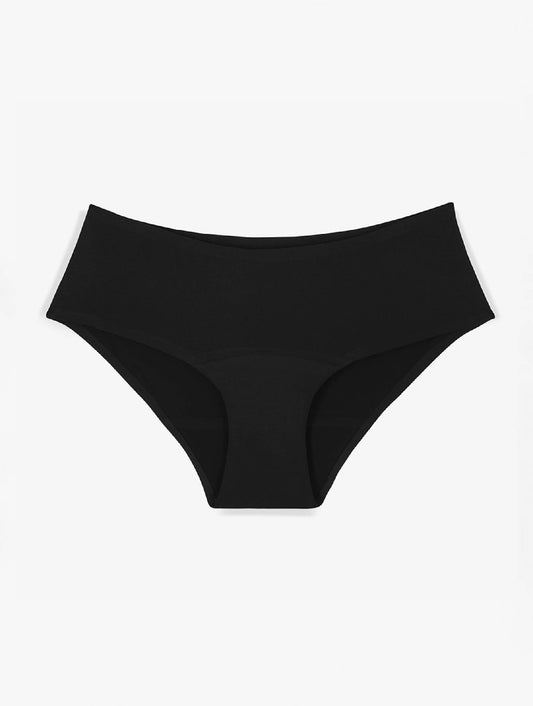Bleeding periods: causes, symptoms and solutions
When you have hemorrhagic or heavy periods, you spend a few days a month in discomfort, even in pain. Fortunately, there are solutions to solve this problem or live better with them, such as period panties or period swimsuits . But we must first understand the causes and rule out any risk of undetected disease.

Ara cotton menstrual panties
35,00 €
24,50 €







Where does menstrual blood come from?
Bleeding during periods comes from the uterine lining which is renewed at the end of the cycle, when fertilization has not occurred after ovulation. This periodic mechanism begins at puberty and stops with menopause.
In theory, the menstrual cycle lasts 28 days. In practice, under the influence of hormones, it is not uncommon for the length of the cycle to differ from one month to the next and from one woman to another. As for the duration and volume of periods, it's the same thing: everything is variable. But, in general, we agree that the “normal” duration is between 3 and 6 days, while the “normal” bleeding volume is below 80 ml.
When periods exceed this duration or these quantities (or both), we may be in the presence of menorrhagia (hemorrhage during periods in women of childbearing age, outside of pregnancy).
Bleeding periods, but to what extent?
We speak of heavy periods or hypermenorrhea when the quantity of blood evacuated during menstruation exceeds 80 ml, the equivalent of a coffee cup.
If the duration of bleeding exceeds 6 days, we then speak of hemorrhagic periods or menorrhagia.
If bleeding occurs outside of menstruation, it is called metrorrhagia. When bleeding occurs throughout the menstrual cycle (during and outside the period), we speak of meno-metrorrhagia.
To calculate your flow, you can refer to the Higham score with an easy-to-use table. During a cycle, you will report, among other things, the time in hours before each change of periodic pad or tampon (be careful, never exceed 4 hours for internal protection to avoid the risk of toxic shock ). Each napkin or tampon corresponds to a number of points. At the end of the period, the number of points is counted.
If the Higham score is greater than 100 points, the bleeding is greater than 80 ml. We are facing a case of menstrual bleeding.
If the Higham score is greater than 150, we are faced with a case of menstrual bleeding requiring medical attention.
When completing your table, do not hesitate to also observe if your bleeding contains blood clots.
Bleeding periods: is this worrying for my health?
Bleeding periods can cause a reduction in red blood cells, which bind iron in the blood and allow the transport of oxygen. This is iron deficiency anemia (anemia due to a drop in iron reserves). This iron deficiency leads to fatigue, migraines, dizziness and even shortness of breath. It is indeed a menstrual cycle disorder. Added to this are the pains caused by menstruation. But if the causes and consequences of heavy bleeding are generally not serious, they can be symptoms of an undetected health problem (ectopic pregnancy, endometrial infection, benign tumors, etc.). It is therefore imperative to talk to your gynecologist about your cycle problem.
Why are my periods heavier than average?
Most often, menorrhagia is due to a hormonal imbalance. This may be an excess of estrogen or a deficiency of progesterone, or both. These causes are common during adolescence and then at menopause.
But there are other possible factors:
- wearing a copper IUD (IUD), particularly during the first 6 months;
- taking anticoagulants;
- a blood clotting abnormality;
- the consequences of a miscarriage;
- absence of ovulation;
- a lesion of the uterine mucosa such as endometriosis;
- a fibroid, cyst or polyp located in the uterine cavity causing bleeding;
an ectopic pregnancy in rarer cases.
Menorrhagia: is it treatable?
Yes, living with bleeding periods is not inevitable. Many solutions help reduce bleeding and increase comfort.
First, your doctor or gynecologist will ask you about your symptoms. Then, he will certainly carry out an ultrasound or uteroscopy to check the causes of these hemorrhages. When the diagnosis is made, several treatments can be considered.
In the event of a hormonal imbalance, the simplest solution will be to take appropriate contraception, such as an estrogen-progestin pill or a hormonal IUD or even a supply of hormones such as progesterone. In the event of a fibroid, polyp or cyst, a surgical operation such as laparoscopy will allow its removal. In the case of endometriosis , menstruation can be suppressed chemically to put the body at rest for a while. In the event of menopause, if you are under hormone-based treatment: the gynecologist will interrupt the THM (hormonal treatment for menopause) firstly in order to readjust it later.
To reduce the amount of bleeding, your gynecologist may still prescribe anti-fibrinolytics, medications that regulate blood clotting. If this fails, a surgeon may offer you an endometrectomy, that is to say an abrasion of the lining of the uterus (the endometrium) or a surgical resection to reduce the volume of your menstruation.
In all cases, you will be prescribed iron if you have a deficiency to regain maximum energy!
What protection should you choose in case of heavy or hemorrhagic periods?
Towel, tampon, cup or menstrual panties: to deal with heavy or bleeding periods it is better to be well protected! At SMOON, we are 100% for menstrual panties! For what ? Because it is made from OEKO-TEX® STANDARD 100 material (certifying the absence of chemical substances harmful to the planet or your health), guaranteed to be leak-proof, anti-humidity, anti-odor and can absorb between 15 and 20 ml of blood. If the abundance of your bleeding has no serious pathological origin or any significant consequence (apart from the obligation to change your sanitary protection frequently), investing in menstrual panties will change your life. Feeling comfortable even during bleeding periods is possible!
By Valérie











































